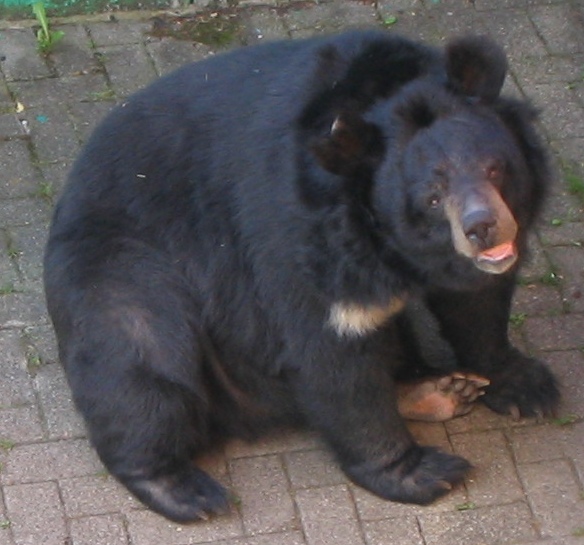|
| Query: Ursus | Result: 8th of 759 | |
Asiatic Black Bear (Ursus thibetanus) - Wiki
| Subject: | Asiatic Black Bear (Ursus thibetanus) - Wiki
| |

| Resolution: 584x545
File Size: 116485 Bytes
Date: 2005:07:20 16:22:08
Camera: Canon DIGITAL IXUS II (Canon)
F number: f/3.9
Exposure: 1/80 sec
Focal Length: 346/32
Upload Date: 2006:12:26 11:08:24
|
Asiatic Black Bear
From Wikipedia, the free encyclopedia
[Photo] Asiatic Black Bear (Ursus thibetanus). Recorded by Flominator at Schwarzwaldpark L??ffingen on July 20, 2005.
The Asiatic Black Bear (Ursus thibetanus), also known as the Tibetan black bear, the Himalayan black bear, or the moon bear, is a medium sized, sharp-clawed, black-coloured bear with a distinctive white or cream "V" marking on its chest. It is a close relative of the American black bear with which it is thought to share a European common ancestor.
It grows to approximately 130 to 190 cm (4¼ to 6¼ ft) in length. Males weigh between 110 and 150 kg (240 to 330 lb) and females weigh between 65 to 90 kg (140 to 200 lb). The bear's life span is around 25 years.
The Asiatic Black Bear has a wide distribution range spanning from the east to west of the Asian continent. This bear can be found in the forests of hilly and mountainous areas in East Asia and South Asia, including Afghanistan, Pakistan, northern India, Nepal, Sikkim, Bhutan, Burma, southern Siberia in Russia, northeastern China, Taiwan and Japan. It can be found in areas with elevations as high as 4,700 m (9,900 feet), but in lower lands as well. In some parts of its range, the Asiatic black bear shares its habitat with the larger and stronger brown bear (Ursus arctos). However, the smaller black bear has an advantage over its competitor: its climbing skills which help it reach for fruit and nuts in the trees. Asiatic Black Bears share Giant Panda habitat in China's Wolong Reserve, where they feed occasionally, among other things, on bamboo, which is their more specialized relatives' favorite food. The Asiatic Black Bear type that is found in Taiwan is the Formosan Black Bear subspecies.
The Asiatic Black Bear is an omnivore which consumes a great variety of foods including fruit, berries, grasses, seeds, nuts, invertebrates, honey and meat (fish, birds, rodents and other small mammals as well as carcasses). The Asiatic Black Bear is thought to be somewhat more carnivorous than its American cousin. Nevertheless, meat only makes up a small part of its diet.
The bear has been known to be quite aggressive towards human beings (more so than the American black bear); there have been numerous records of bear attacks and killings. This is probably mainly due to the fact that the Asiatic Black Bear is more likely to come into contact with people, and will often attack if startled.
The Asiatic Black Bear is listed as vulnerable on the World Conservation Union's (IUCN's) Red List of Threatened Animals. It is threatened mainly by deforestation and habitat loss. The bears are also killed by farmers due to the threat they pose to livestock, and they are also unpopular for their habit of stripping bark from valuable timber trees.
Asiatic Black Bears are also threatened by hunting, especially for their gall bladders to obtain bile, which is used in traditional Chinese medicine. Since China outlawed the poaching of native bears in the 1980s, bear bile has been supplied to Chinese consumers by special farms, where the bears are kept constantly caged and restrained while catheters inserted in their gall bladders allow bile to drip into a container and be collected. Supporters of this practice contend that, without these farms, the demand for bear bile would create a tremendous incentive for poaching and put the already endangered species at even greater risk. Critics, however, assert that the practice is patently cruel and inhumane, and that synthetic bear bile, ursodeoxycholic acid, is just as medicinally effective as real bear bile, and in fact much cheaper.
Subspecies
- Formosan Black Bear, Ursus thibetanus formosanus, or Selenarctos thibetanus formosanus - in Taiwan
- Ursus thibetanus gedrosianus, or Selenarctos thibetanus gedrosianus - in Iran and Pakistan
- Ursus thibetanus japonica, or Selenarctos thibetanus japonica - in Japan
- Ursus thibetanus laniger, or Selenarctos thibetanus laniger - in Afghanistan and southeast Iran and southern China
- Ursus thibetanus mupinensis, or Selenarctos thibetanus mupinensis - in southwestern China
- Ursus thibetanus thibetanus, or Selenarctos thibetanus thibetanus - in Himalaya and Indochina
- Ursus thibetanus ussuricu, or Selenarctos thibetanus ussuricu - in Southern Siberia, northeastern China and Korean peninsula
http://en.wikipedia.org/wiki/Asiatic_Black_Bear
| The text in this page is based on the copyrighted Wikipedia article shown in above URL. It is used under the GNU Free Documentation License. You may redistribute it, verbatim or modified, providing that you comply with the terms of the GFDL. |
|
^o^
Animal Pictures Archive for smart phones
^o^
|
|

